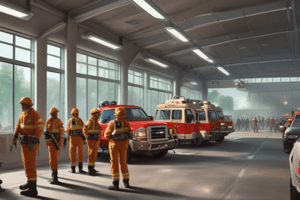Podcast
Questions and Answers
Who initiates Command (IC #1) when the incident first arrives?
Who initiates Command (IC #1) when the incident first arrives?
- The first-arriving unit (correct)
- The last-arriving unit
- Any RFA member
- The first-arriving Chief Officer
When should a Chief Officer assume Command of the incident?
When should a Chief Officer assume Command of the incident?
- Only after IC #1 has left the scene
- When directed by IC #1
- Immediately upon arrival at the scene
- After the completion of Transfer of Command procedures (correct)
What is the preferred method for IC #2 to communicate with IC #1 during the transfer of Command?
What is the preferred method for IC #2 to communicate with IC #1 during the transfer of Command?
- Email communication
- Written report
- Face-to-face communication (correct)
- Radio communication
What should IC #1 include in the briefing for IC #2?
What should IC #1 include in the briefing for IC #2?
In which scenario is it permissible for IC #1 to transfer Command to a Chief Officer?
In which scenario is it permissible for IC #1 to transfer Command to a Chief Officer?
Who may not be given Command of the incident during the transfer?
Who may not be given Command of the incident during the transfer?
What is one of the safety considerations IC #1 must inform IC #2 about?
What is one of the safety considerations IC #1 must inform IC #2 about?
What does the Tactical Objectives refer to in the briefing process?
What does the Tactical Objectives refer to in the briefing process?
Which of the following should NOT be included in the briefing from IC #1 to IC #2?
Which of the following should NOT be included in the briefing from IC #1 to IC #2?
Study Notes
Command and Transfer of Command
- The first unit arriving at an incident initiates command (IC #1), regardless of rank.
- The first arriving Chief Officer assumes command after completing transfer of command procedures, becoming (IC #2).
- If a Chief Officer arrives at the same time as the initial unit, the Chief Officer assumes command.
- Command cannot be transferred to an officer not present at the scene.
Transfer of Command Procedures
- Command is transferred via radio or face-to-face, with face-to-face communication preferred.
- The officer taking over command (IC #2) will receive a briefing from the current commander (IC #1) including:
- Incident conditions (fire location and extent, Hazmat spills, or release, number of patients, etc).
- The incident management plan.
- The completion of tactical objectives.
- Safety considerations.
- Deployment and assignment of operating companies and personnel.
- Needed additional resources.
Studying That Suits You
Use AI to generate personalized quizzes and flashcards to suit your learning preferences.
Related Documents
Description
This quiz covers the essential procedures for initiating and transferring command in emergency incidents. It highlights the roles played by the first responders and the Chief Officer during the transfer of command, as well as the critical information exchanged. Test your knowledge on effective incident command operations.




